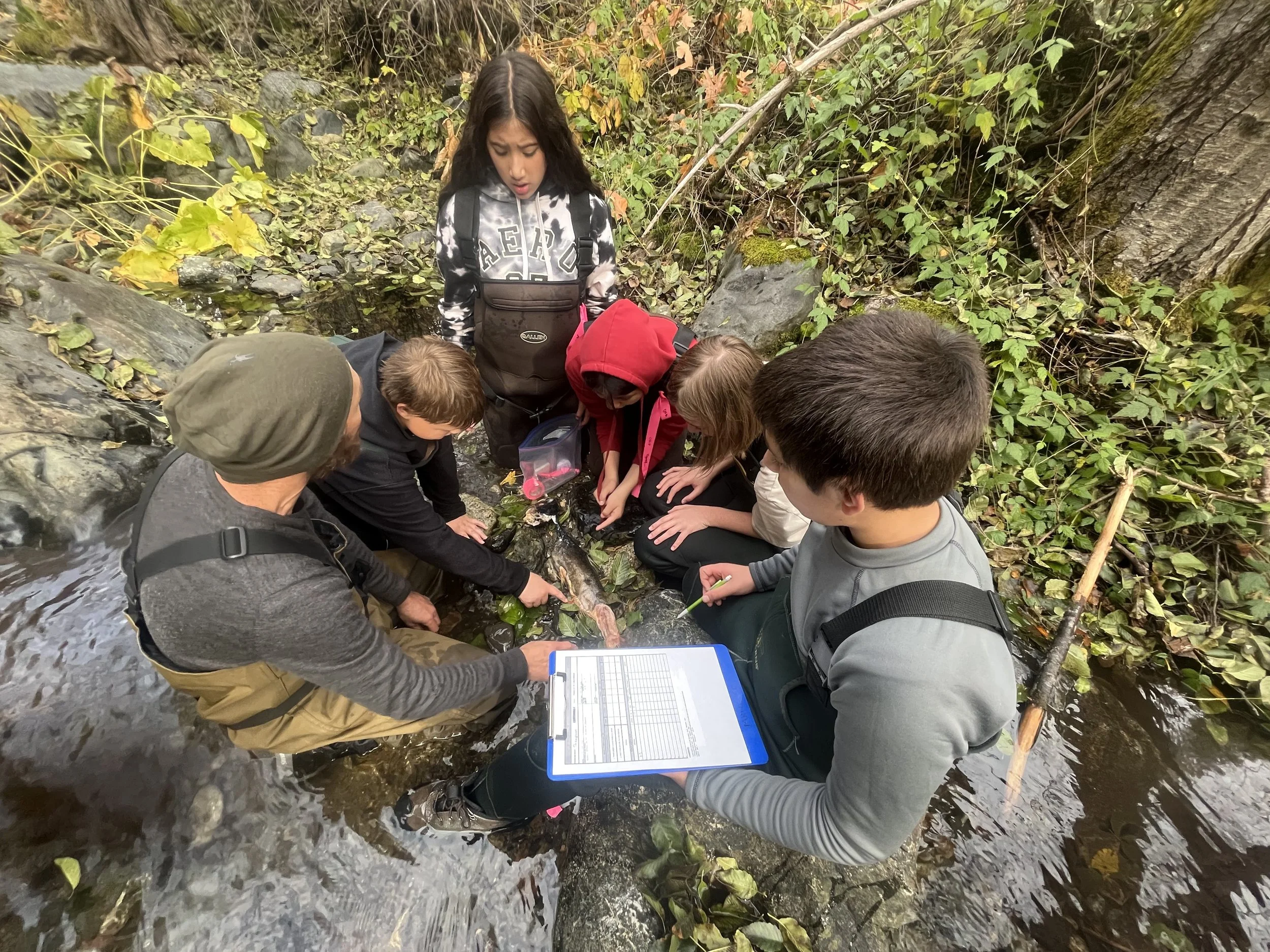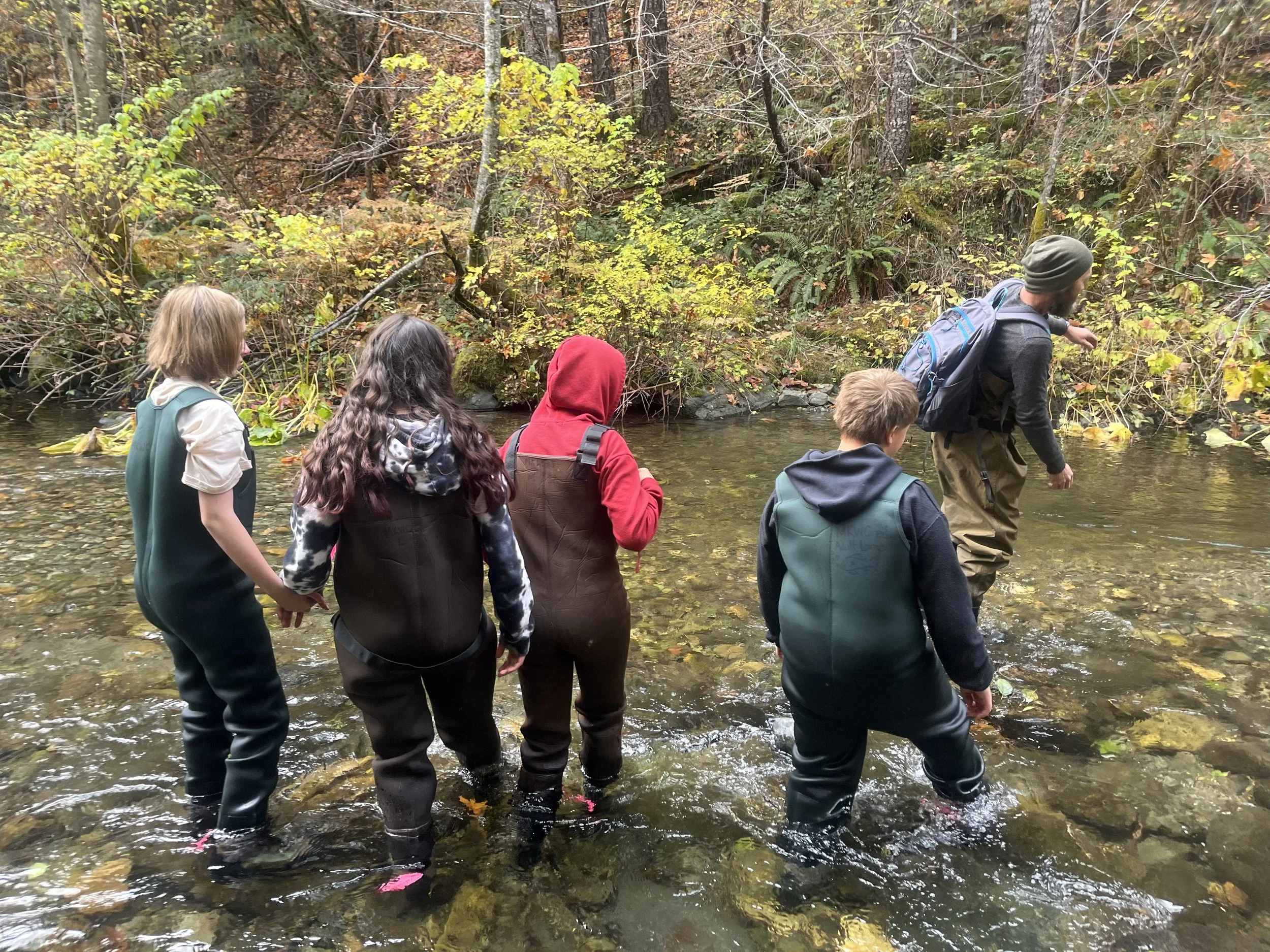Fall Salmon Survey Field Trips: Local Youth Doing Hands-on Science
“I really hope we find a carcass!”
We are five middle school students from Happy Camp Elementary School and two fisheries technicians from the Mid Klamath Watershed Council winding along the Klamath River on our way to survey the Chinook salmon run on a section of Thompson Creek. Leaving the river road, we head up into the Thompson Creek drainage, and as pavement turns to gravel, we pass through a golden yellow tunnel of big leaf maples. The vehicle is abuzz with excited anticipation as we review what students have recently learned during a pre-survey training. “What in particular will we be looking for in the creek today?” asks a crew leader. “Carcasses!” is the immediate response, but students also remember that we will be looking for live fish and Chinook redds.
We park near a small bridge over Thompson Creek. Already suited up in waterproof waders and stream boots, we start across the bridge towards our put-in. We pause on the bridge to observe the stream. From this vantage, students identify a lighter patch of gravel in the streambed as a possible redd. A female Chinook has likely dug there with her tail to mound the gravel into a nest, or redd, where she deposits eggs. The digging exposes cleaner gravel giving the redd its telltale lighter appearance. We agree to take a closer look at the spot when we are down in the creek. Eventually, students start to look over the other side of the bridge, and suddenly someone spots it. There on the rocky bank of the creek, halfway in the water, lies the object of our hopes; an adult Chinook salmon carcass!
Student participants take data on a fall Chinook salmon carcass.
When we arrive at the carcass, we see that it has been partially consumed by wildlife, but there is enough of the fish left to collect the samples we need. The samples will be sent to a lab to be cataloged and will provide information important for understanding Chinook salmon and for making resource management decisions. Despite the slightly rank condition of the carcass, two of the students are eager to help collect samples, while the others prefer to help by recording information on the data sheet and preparing envelopes for the samples. First, the species and sex are determined. Students identify the fish as a female because it has a white tail. The tail of a spawned female is white because the skin has rubbed off while digging her redd. The fork length is measured from nose to tail and recorded at 70cm. A student then collects scales by scraping a knife from back to front along the side of the fish. Next, another student uses a hole punch to retrieve a tissue sample from the dorsal fin. Finally, it is time to remove the otoliths. Otoliths are two small bones located in the brain cavity that aid in hearing and balance. Scientists can determine a remarkable amount about the life history of a fish from its otolith, so these ear stones are valuable samples. However, they can be tricky to find. One of the crew leaders cuts a neat wedge from the top of the fish’s head exposing a window into the brain cavity and demonstrates how to find and remove one of the otoliths. A student tries for the second otolith, sliding a pair of tweezers carefully around the brain down into the depression at the base of the skull. After only a few attempts, the prized and delicate ear stone is deftly removed and triumphantly deposited into its envelope. Sampling completed, the carcass is returned to the stream.
With a feeling of accomplishment, the group of young scientists continues their survey up the stream. The lighter patch of gravel they had spotted from the bridge does turn out to be a new redd. Students use a GPS to mark the location and record the coordinates on the data sheet. Taking care not to step on the redd or disturb the area, they hang a strip of pink flagging marked with the date and their initials on a nearby branch so that this redd will not be recounted by the next survey team. By the end of the survey, the crew has marked five new redds and recorded two adult Chinook salmon, one Chinook carcass, and one Pacific Giant salamander.
On the return drive, a little wet and bruised but also invigorated by the creek adventure, all five of the students declare that this was the first time they had ever seen a salmon redd. It has been a few years since the program has been offered at their school, so this was their first opportunity. However, for over 20 years, students in the region have participated in the Klamath Basin Cooperative Salmon Spawning Ground Surveys. These salmon surveys involve organizations from all over the Klamath Basin, including the Yurok Tribe, Karuk Tribe, Quartz Valley Indian Community, U.S. Fish and Wildlife Service, U.S. Forest Service, Salmon River Restoration Council, Mid Klamath Watershed Council, local schools, and more. The mission of the salmon survey is to gather information needed to make sound management decisions affecting salmonid species in the Klamath Basin. The data collected by field crews are analyzed and interpreted by fisheries professionals and are used by the responsible agencies to set fishing regulations. These regulations are designed to conserve the salmonid populations for future generations.
Involving local students in the salmon survey provides memorable, environmental education opportunities. Students enjoy the remarkable fall beauty of the Klamath River tributaries and witness the astonishing phenomena of salmon spawning at the end of their arduous journey. Students are integral to the effort as they count, measure, sample, and fill out data sheets just like any fisheries professional conducting a survey. They must learn how to identify a redd, accurately measure redds and fish lengths, read a stream map, use a GPS, collect tissue, scale, and otolith samples from carcasses, cross a stream safely, walk carefully as to not disturb spawning salmon, and correctly fill out a datasheet. Student participants develop regionally relevant career skills, and give back to the land and their community by engaging in natural resource monitoring.
Sixty miles downriver from Thompson Creek, students from Orleans Elementary School are surveying a section of Camp Creek. They stop and watch a female salmon building her redd. She flips on her side, acrobatically wiggling her tail to work the cobble. By gradually digging a pit, she mounds up the loosened gravel into a redd that will provide the ideal conditions for her spawn’s earliest stages of life. A large male is by her side chasing off and nipping at the tales of the two younger males, called “jacks”, whenever they swim too close. It is quite a scene! The crew watches the drama unfold for about 20 minutes, making up personalities for the fish and narrating the show, exclaiming it was better than watching tv.
"Salmon surveys are like all the school subjects at once. There is math, science, PE.... and therapy."
Thanks to everyone that made these field trips happen: Klamath-Trinity Joint Unified School District, Happy Camp Elementary School District, USFS Orleans, USFS Happy Camp, CA Department of Fish & Wildlife, US Fish & Wildlife Service, Salmon River Restoration Council, CA State Parks Outdoor Equity Program


